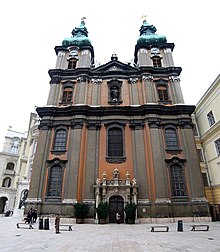Church_of_St._Mary_the_Virgin,_Budapest
Church of St. Mary the Virgin, Budapest
Historic church in Budapest, Hungary
The Church of St Mary the Virgin (Hungarian: Kisboldogasszony-templom), commonly known as the University Church (Hungarian: egyetemi templom), is a Catholic Church in the Papnövelde Street, Belváros-Lipótváros District (Inner City District) in Budapest, Hungary. From 1786 the church belongs to the former Theological Faculty of the Eötvös Loránd University, and to the Pázmány Péter Catholic University independent of it; before it was the central church of the Pauline Order. The Central Priestly Educational Institute operates in a block adjacent to the church, so that the liturgical services of the church are performed by the priestly students and the chiefs of the institute. The church has two towers and its towers are 56 meters high.
This article has multiple issues. Please help improve it or discuss these issues on the talk page. (Learn how and when to remove these template messages)
|


